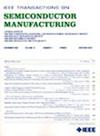考虑低gwp的COF2替代PECVD室清洁气体
IF 2.3
3区 工程技术
Q2 ENGINEERING, ELECTRICAL & ELECTRONIC
引用次数: 0
摘要
PECVD环境中的连续沉积过程对于确保薄膜在各种应用中的均匀性和可重复性至关重要。二氧化硅(SiO2)因其优异的性能而广泛应用于这些工艺中,但会在PECVD腔室中留下残留材料,导致材料堆积,从而影响工艺的一致性和可重复性。在3D-NAND闪存的制造中,涉及到氧化氮(ON)堆叠工艺,这是工艺一致性和可重复性受损的一个典型例子。有效的腔室清洗是必不可少的,以确保连续沉积过程的一致和可重复的性能。三氟化氮(NF3)是一种常用的室内清洁气体,由于其具有较高的全球变暖潜能值(GWP),可能带来环境和工业风险,有望成为温室气体法规的新成员。在本研究中,我们探索了羰基氟化物(COF2)作为低GWP的替代室清洁气体的潜力,尽管与NF3相比,其清洁率较低。本研究研究了等离子体环境下的气体解离,分析了等离子体的种类和沉积膜表面的变化对清洁速度的影响。在此基础上,考虑影响等离子体增强化学气相沉积(PECVD)腔室清洗效率的因素,对COF2的清洗工艺设计进行了改进。本文章由计算机程序翻译,如有差异,请以英文原文为准。
An Alternative PECVD Chamber Cleaning Gas of COF2 for Low-GWP Consideration
Continuous deposition processes in PECVD environments are critical for ensuring the uniformity and reproducibility of thin films across various applications. Silicon dioxide (SiO2), widely used in these processes for its excellent properties, can leave residual materials in PECVD chambers, leading to material buildup that compromises process consistency and reproducibility. A representative example of compromised process consistency and reproducibility is found in the manufacturing of 3D-NAND flash memory, which involves oxide-nitride (ON) stacking processes. Effective chamber cleaning is essential to ensure consistent and reproducible performance in continuous deposition processes. Nitrogen trifluoride (NF3), a commonly used as chamber cleaning gas, is expected to be newly belong to the greenhouse gas regulations due to its high global warming potential (GWP), which may pose both environmental and industrial risks. In this study, we explored the potential of carbonyl fluoride (COF2) as an alternative chamber cleaning gas with low GWP, albeit with an inferior cleaning rate compared to NF3. This study investigates gas dissociation in the plasma environment and analyzes plasma species and changes in the deposited film surface affecting the cleaning rate. Based on the results, proposed improvements are made to the cleaning process design for COF2, considering factors influencing plasma enhanced chemical vapor deposition (PECVD) chamber cleaning efficiency.
求助全文
通过发布文献求助,成功后即可免费获取论文全文。
去求助
来源期刊

IEEE Transactions on Semiconductor Manufacturing
工程技术-工程:电子与电气
CiteScore
5.20
自引率
11.10%
发文量
101
审稿时长
3.3 months
期刊介绍:
The IEEE Transactions on Semiconductor Manufacturing addresses the challenging problems of manufacturing complex microelectronic components, especially very large scale integrated circuits (VLSI). Manufacturing these products requires precision micropatterning, precise control of materials properties, ultraclean work environments, and complex interactions of chemical, physical, electrical and mechanical processes.
 求助内容:
求助内容: 应助结果提醒方式:
应助结果提醒方式:


